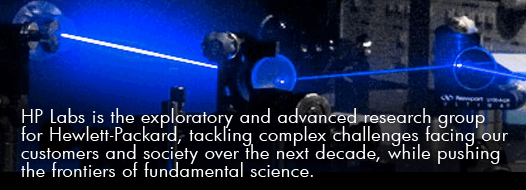About HP Labs
|
 |
|
Our research spans a wide range of technical disciplines and touches all of HP's businesses. Collectively, we are applying our expertise in these areas to address eight opportunities that we believe are crucial to defining the future of information technology:
- Cloud and Security – Delivering the secure application and computing end-state of Everything-as-a-Service.
- Information Analytics – Turning enormous and rapidly increasing amounts of enterprise information into relevant business insight.
- Intelligent infrastructure – Designing a system of smarter, more secure enterprise computing devices, networks, and storage built on scalable architectures. It’s about creating technology that blends into the way we work and live our lives as individuals and in business.
- Mobile and Immersive Experiences – Designing compelling user experiences that fundamentally change how people communicate, collaborate, socialize, and entertain---utilizing multimedia technologies to deliver intuitive, interactive, mobile, and immersive audio-visual experiences.
- Networking and Communication – Creating the next generation of network architectures and communications technologies, which provide predictable, high-quality and power-efficient networking while reducing management complexity.
- Printing and Content Delivery – Transforming inflexible, manual mass production printing processes to flexible, customized, on-demand printing processes which are enabled by new digital technologies that allow for lower cost, higher quality commercial printing.
- Services – Creating technologies and processes that deliver new ways to leverage data across different formats and business disciplines, enabling faster, better informed decision-making.
- Sustainability – Creating technologies, IT infrastructure and new business models that promote low emissions, save money and leave a lighter footprint on the environment.
Open innovation
We put a strong emphasis on open innovation, collaborating with universities, customers and partners, and governments to gain insights and to amplify the work of our 600 researchers. Through our Open Innovation Office we are deepening these relationships and ensuring that joint research endeavors result in high-impact research that meets the scientific and business objectives of HP and its partners.
Leadership and organization
HP Labs operates under the direction of Prith Banerjee, Senior Vice President of Research for HP. We are organized into seven labs and four research groups located in seven major sites: in Palo Alto, USA; Bangalore, India; Beijing, China; Bristol, UK; Haifa, Israel; Fusionopolis, Singapore; and St. Petersburg, Russia. HP Labs also has significant research teams in Princeton, USA and in Barcelona, Spain.
Technology contributions
In 1966, Bill Hewlett and Dave Packard decided to create a central research lab for HP to free scientists from day-to-day business problems so they could focus on ideas that would help shape the company's future.
HP Labs has a long history of technical achievements including such well-known early innovations as pocket scientific calculator (1972), thermal inkjet printing (1984) and RISC architecture (1986).
In the past two decades, our contributions have ranged from optical sensing technology used in cordless mice (1998), to the world's first molecular logic gate (1999), a fundamental step in the creation of chemically assembled electronic nanocomputers, to Jena, the most popular toolkit for Semantic Web developers (2000).
HP Labs began its pioneering work in what is now known as sustainable IT in 2000, resulting in hundreds of patents and several HP products, including Dynamic Smart Cooling (2006) which reduces data center cooling costs by 25 to 40 percent.
» HP Labs timeline (1966-2006)
» 40 years of contribution (history)
» Former directors
Other recent innovations include:
- Tycoon market-based allocation system for computing resources (2004)
- Gesture-based keyboard (2006)
- Memory Spot wireless data chip (2006)
- Mscape toolkit for creating location-based games, tours, experiences (2007)
- Hybrid chip architecture for low-power, high-performance computing (2007)
- Smart skin patch for painless injections (2007)
- Self-aligned imprint lithography (2008)
- The fourth basic element in integrated circuits: Memristor (2008)
